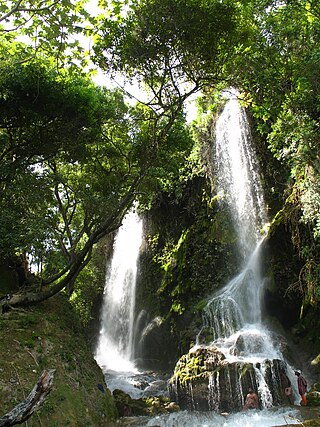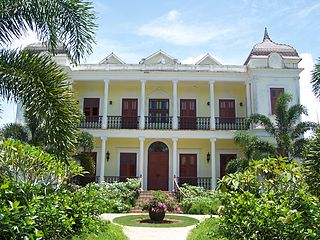
Enrique Arturo Laguerre Vélez was a teacher, novelist, playwright, critic, and newspaper columnist from Moca, Puerto Rico. He is the author of the 1935 novel La Llamarada, which has been for many years obligatory reading in many literature courses in Puerto Rico.

Edmond Nicolas Laguerre was a French mathematician and a member of the Académie des sciences (1885). His main works were in the areas of geometry and complex analysis. He also investigated orthogonal polynomials. Laguerre's method is a root-finding algorithm tailored to polynomials. He laid the foundations of a geometry of oriented spheres, including the Laguerre transformation or transformation by reciprocal directions.
Events from the year 1834 in France.

Saut-d'Eau is a commune in the Mirebalais Arrondissement, in the Centre department of Haiti. It has 34,885 inhabitants.
Zatrephes mirabilis is a Neotropical species of moths in the family Erebidae. It is found in French Guiana.

Lophocampa is a genus of moths in the family Erebidae. The genus was erected by Thaddeus William Harris in 1841. It contains around 75 species.

Opharus is a genus of moths in the family Erebidae. The genus was erected by Francis Walker in 1855.

Trichromia is a genus of moths in the family Erebidae erected by Jacob Hübner in 1819. The members of this genus are largely indigenous to South America.

Palacete Los Moreau is a house museum located in Moca, Puerto Rico. Historically known as the Labadie Mansion, the house inspired writer Enrique Laguerre to write La Llamarada. The property was restored as a museum and renamed the Palacete Los Moreau in honor of Laguerre's novel. It's listed on the National Register of Historic Places as Hacienda Iruena Manor House, and on the Puerto Rico Register of Historic Sites and Zones as the Labadie House.

Fetcham Park House is a Queen Anne mansion designed by the English architect William Talman with internal murals by the renowned artist Louis Laguerre and grounds originally landscaped by George London. It is located in the parish of Fetcham near Leatherhead in Surrey.

Lophocampa griseidorsata is a moth in the family Erebidae first described by Vincent and Laguerre in 2013. It is found in Bolivia, Ecuador and Peru.

The Pericopina is a subtribe of tiger moths in the family Erebidae. The subtribe was described by Francis Walker in 1869.
Opharus corticea is a moth of the family Erebidae. It was described by Francis Walker in 1856. It is found in Venezuela.
Opharus bipunctatus is a moth of the family Erebidae. It was described by Vincent and Laguerre in 2009. It is found in the Dominican Republic.
Spherical wave transformations leave the form of spherical waves as well as the laws of optics and electrodynamics invariant in all inertial frames. They were defined between 1908 and 1909 by Harry Bateman and Ebenezer Cunningham, with Bateman giving the transformation its name. They correspond to the conformal group of "transformations by reciprocal radii" in relation to the framework of Lie sphere geometry, which were already known in the 19th century. Time is used as fourth dimension as in Minkowski space, so spherical wave transformations are connected to the Lorentz transformation of special relativity, and it turns out that the conformal group of spacetime includes the Lorentz group and the Poincaré group as subgroups. However, only the Lorentz/Poincaré groups represent symmetries of all laws of nature including mechanics, whereas the conformal group is related to certain areas such as electrodynamics. In addition, it can be shown that the conformal group of the plane is isomorphic to the Lorentz group.
Pseudepimolis is a genus of moths in the family Erebidae. It was erected by Benoît Vincent and Michel Laguerre in 2013.
Events from the year 1663 in France
Démosthènes Pétrus Calixte was a Haitian conservative Noirist politician and military figure who led the Garde d'Haïti. In 1937, Calixte became involved in political chaos, where officers within the Garde tried to overthrow president Sténio Vincent and replace him with Calixte. This led to the replacement of Calixte, who fled to the Dominican Republic. Upon his return in the 1940s, Calixte was made a presidential candidate by the Mouvement Ouvriers et Paysans in 1946. However, he lost the election to Dumarsais Estimé.

Trichromia supracoccinea is a species of moth from in the family Erebidae. The species was first described by Benoît Vincent and Michel Laguerre in 2017.










